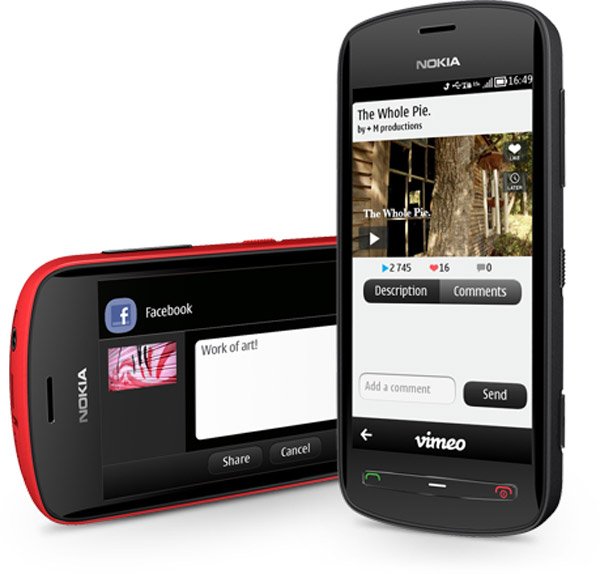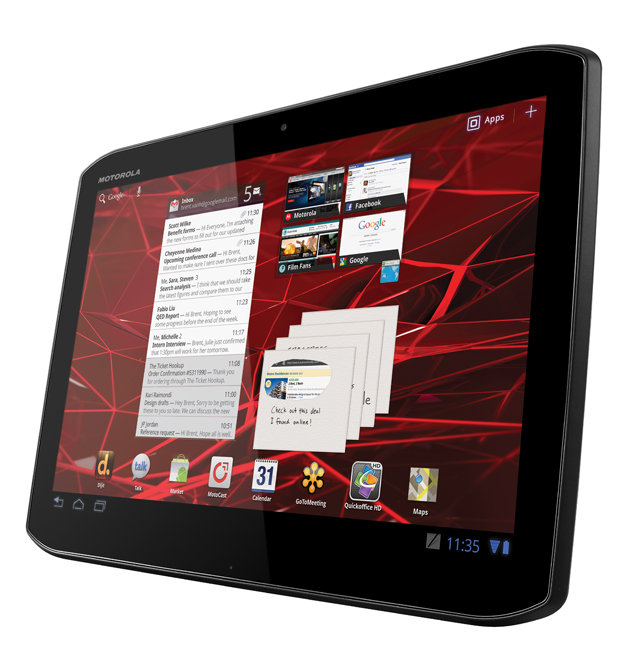Samsung Galaxy Tab 7.7 WiFi+3G P6800 16GB 
The 7 inch Android tablet market has been rather hit and miss so far, with the first iteration of the Galaxy Tab being the only real contender and most of the focus on the 10” category, and for good reason – that’s been the mainstay of Apple’s iPad up till now, and manufacturers have been innovative and creative with their offerings in order to stay relevant and have a chance of competing in that space.
The Galaxy Tab 7.7 takes a completely different tact, being lighter and slimmer than, well, any Honeycomb-based tablet we’ve seen so far. Compared to the original Tab which relied on a reworked mobile phone OS, it’s a much more mature product and fits snugly between a smartphone and large screen tablet. This may actually be the product to redefine what a small screen tablet is capable of.
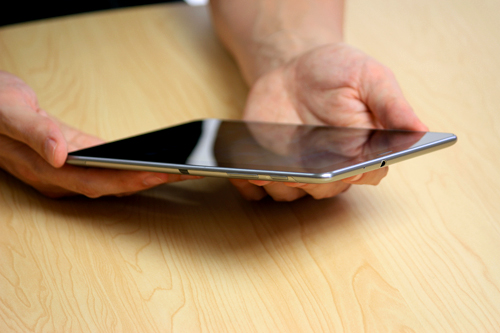
Small, sleek and ready to slip into any size handbag or pouch.
Spec-wise, the Galaxy 7.7 is powered by a dual core 1.4GHz processor with 1GB of RAM, and will apparently come in three flavours – 16GB, 32GB and 64GB. It has N wireless on board, Bluetooth 3.0 and has a built-in GPS.
Samsung’s new 7 inch Android tablet sports a slightly larger screen, at 7.7 inches, but offers the exact same resolution features as its 10” cousins – 1280 x 800. Combine that with the Super AMOLED Plus screen, and you’ve got gorgeous detailed images and bright, rich colours. Because the pixels are so densely packed together, the screen display is second-glance-worthy. The small amount of video files we had played back smoothly in high definition.
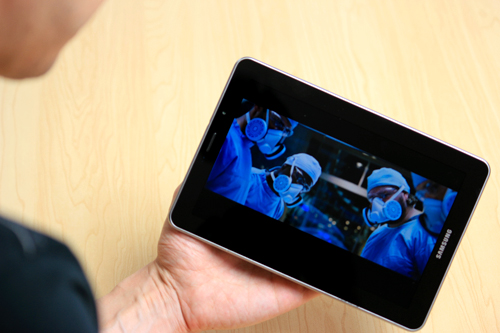
Video playback up to 1080p on the Galaxy Tab 7.7.
I really haven’t held a tablet as light as this one. It’s only 340 grams, but it’s hard to describe what that means after holding various iOS, Android and Windows tablets – sure, this one is smaller than they are in terms of size, but the experience of holding one is amazing. I once commented in an earlier article how I’ve injured myself by falling asleep and dropping a first gen iPad on my face while reading… you’re in no danger of self-mutilation or embarrassment here.
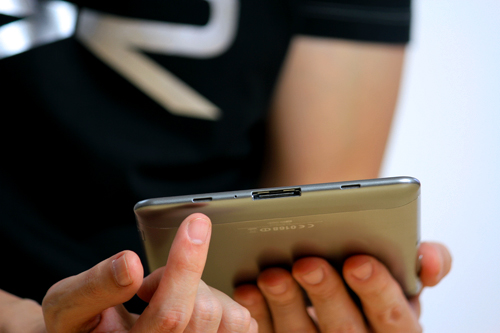
Audio is pumped through these stereo speakers either side of the proprietary connector.
Did I mention how thin the Galaxy Tab 7.7 is? We’ve seen the Transformer Prime come in at 8.3mm, but the 7.7 takes “slim” to yet another level – it’s a sliver of a tablet at 7.89mm. To pick it up and rotate its dimensions in your hand is quite the chuckle producer – you don’t believe how thin and light it actually is.
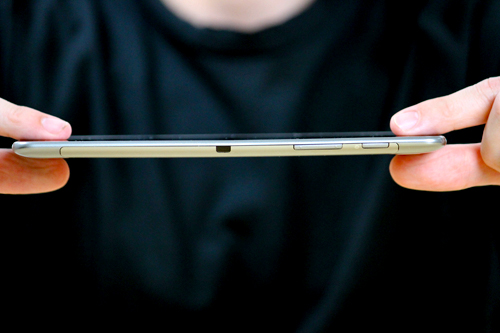
Ridiculously thin... The Galaxy Tab 7.7 is lighter and thinner than pretty much any tablet on the market.
This is definitely a one-handed tablet – your fingers do need to spread, but you can also cup your fingers and hold it for a long time without fatigue. The cool metal backing does equalise with your hands temperature after a while, but put it down and the cold feel of stainless steel will once again greet your fingertips.
That’s a great segue into the materials and construction of this latest Samsung Galaxy Tab. Some other 7 inch Android tablet offerings have been rather thick, and felt a little fragile – squeeze the body and creaks have been heard from lesser machines. The engineering on the 7.7 is superb, we could detect no give between the body and screen; they are almost fused together. The metal back provides a stiffness and therefore top-shelf handling experience.
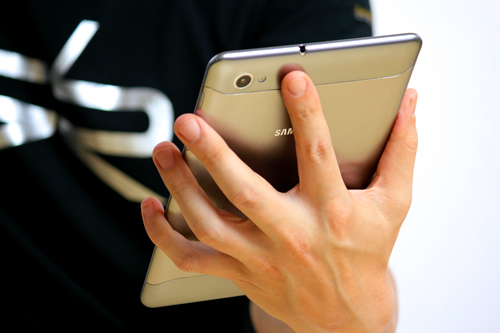
Maybe it's my long fingers that make this pic look odd... In any case the Galaxy Tab 7.7 is easily held in one hand, piano fingers or not.
Walking around this tiny pocket rocket and you can see how Samsung have achieved this degree of slimness: like the iPad and its own family of tablets, the Galaxy Tab 7.7 keeps ports down to an absolute minimum. All we have are a headphone jack, a micro SD card slot and Samsung’s proprietary 30-pin connector. Where most tablets try to offer a complete solution with inputs and outputs, particularly to differentiate against the iPad, the 7.7 follows its own path and offers instead adapters that can be fitted to connect various outputs.
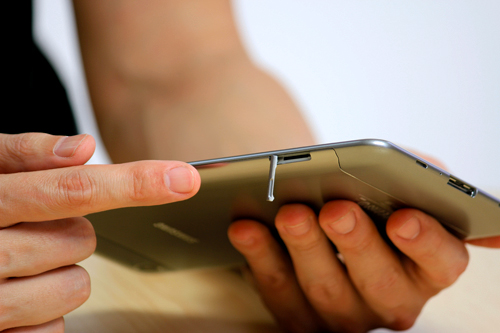
Blink and you'll miss it... An external port on the Galaxy Tab 7.7, in this case a Micro SD Card Slot.
Is that going to be an issue for users? Based on the interest in the 10.1, which offers the same limited connectivity, no. It’s actually more sensible for this Galaxy Tab to eschew those I/O burdens as it’s probably closer to a smartphone than a tablet in some respects (the screen is actually a larger clone of the Galaxy S II). The option is there but you have to really feel the need in order to go to the effort of purchasing an adaptor.
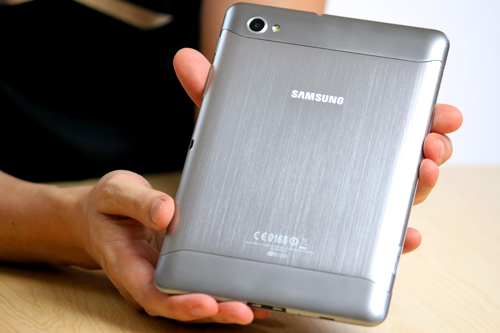
The brushed metal back provides great rigidity to the Galaxy Tab 7.7.
Like all other HoneyComb tablets, there is a front and back camera setup, with a 2 megapixel camera on the front and 3 megapixel camera on the back. The back camera has an LED flash and 720p HD video recording capability. I think there is an inverse proportional relationship of the number of shots taken on a tablet to the size of the screen. Because the 7.7 is so light, it’s much easier to be spontaneous and shoot some off-the-cuff pics and video.

3MP camera and LED flash... The smaller the tablet, the more this will get used.
There is one black dot on the Galaxy Tab 7.7, but its existence helps give it a gold star for functionality. The black dot (not figuratively speaking, an ACTUAL black dot) on the side of the 7.7 is an infra-red transmitter. There is a program pre-installed on the 7.7 called Peel, and it actually converts the 7.7 into a universal remote control. If you’ve ever found remote controls to be clunky or not really that helpful, Peel may change your view on that.
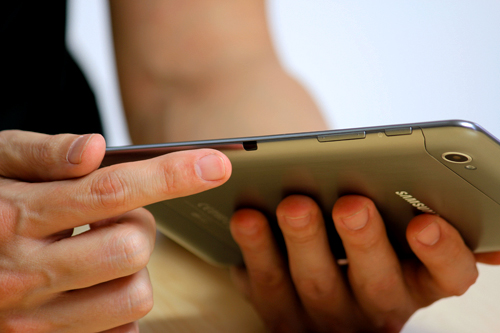
Now not only do I not have to get up to change the channel, I don't even need to find the remote. She says lazy, I say efficient.
Setting it up is a breeze, and so is the actually use, just point at the device you’ve programmed in and it’s as if you’re using the original remote. But this functionality is a stunner, because you can browsing, reading or playing a casual game, use Honeycomb’s built-in multitasking to switch to Peel, change the channel/volume/input, and switch back to your previous activity, and the 7.7 never leaves your hands.
Software-wise, the Galaxy Tab 7.7 uses the same Touch Wiz overlay that their smartphones use, making the transition for Galaxy phone users a no-brainer. There is improved software such as video editing, image editing and even image management, letting you sort by a range of different criteria such as size, location (if geotagging can be found) or date/time.

Galaxy S II users will find no trouble using the Galaxy Tab 7.7.
The Galaxy also retains the “Hub” areas of the smartphone, and apparently the Music Hub will be available soon as well, but only for music, not for videos. I tried the Social Hub out and I liked its aggregation of my different social feeds in one easy to view panel. Being Honeycomb, this is a live widget that updates on screen so you can snack on bite-sized pieces of your connected world.
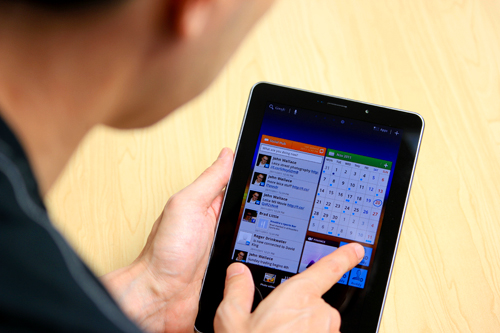
Manage all your social feeds into one panel on the Galaxy Tab 7.7.
The 7 inch Android tablet market is not as big as the 10 inch segment, by any means. It looks like Samsung has managed to carve itself a little niche with a product that doesn’t rely on third party programs to succeed, and adds little quirky features like remote control and revamped image/video apps into its sleek shell to give users a true out-of-the-box experience.
Best Price
Samsung Galaxy Tab 7.7 WiFi+3G P6800 16GB 
is
$599.99Source : http://ritchiesroom.com



































